Overview of initial server platforms in Hostkey.ru
We want to tell you about the entry-level server that Hostkey ( www.hostkey.ru ) uses for most clients. Not so often, a new 2-processor Xeon is needed, but often there is not enough VPS or a special OS configuration is required. Often the client is worried that no one would ever climb his server - full control, encrypted disks, their own admins. If mega-performance is not required, we put the ASUS RS100-X5.
Platform
For the entry level, for unification purposes, we use the ASUS RS100-X5 platform. The motherboard on the 775 socket supports all Core2Duo, Core2Quad, Pentium D and Xeon 33xx, including the new processors on the 45nm process technology. 4 DDR2 memory slots, Intel SATA controller ICH7R for 2 ports (RAID 0.1), 2 Gigabit interfaces. Two closed seats for 3.5 ”HDD, integrated low-profile DVD-ROM. You can install an internal console access module with a separate Eth-port (ASMB3-iKVM) - you can remotely go to BIOS, reboot and monitor the server, etc. There is a PCI_X riser, you can put some specific board in it.
Included is a passive radiator and telescopic slide. As a feature, it is possible to note an amazing silence when the server is operating at a normal load - it is almost inaudible, the power supply of a regular desktop works louder.
')
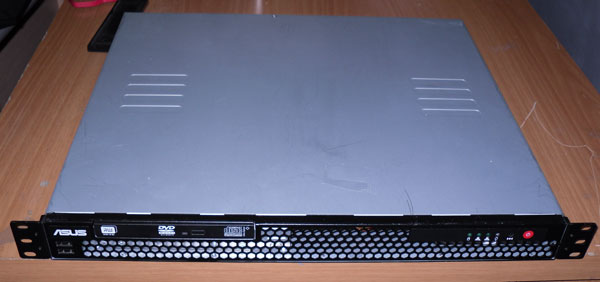
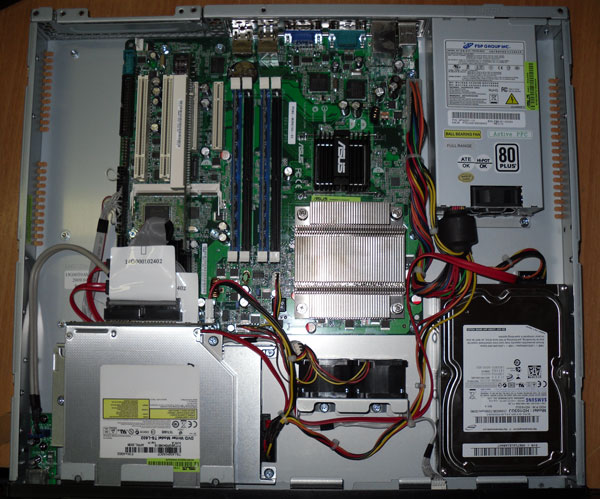
Why precisely she? Firstly, one platform for all socket 775 processors closes the entry-level server niche and excludes the “zoo”. Secondly, low power consumption - about 100W in standby mode and 160W under full load. Thirdly, the support of the new 45nm xeon 33 series protects the investment and extends the service life of the server - in 3-4 years it will be possible to add a processor to the last of the line (which has not yet come out) and continue operation.
Tests
We decided to test one of the temporarily free servers and compare how the system behaves with a Core 2.Duo E7300 2.66GHz processor and a Core2 Quad Q9400 on the same 2.66GHz processor.

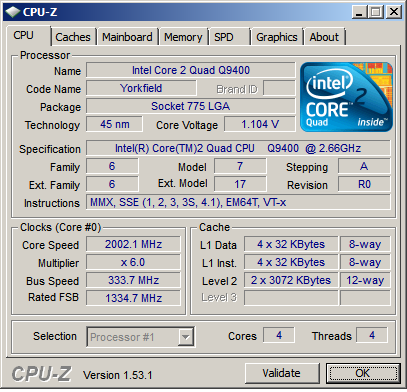
We tested the server with 4GB of memory Kingston, PC2-6400 (400MHz), 2 hard drives - 250GB of Seagate 7200.10, 16M cache and 1Tb Samsung 7200RPM 32M cache, OS - Win2008 Server 64bit. Test program - PassMark PerformanceTest 7.0 and Passmark BurnInTest.

The results are interesting only in comparison (we omit the graphics tests):
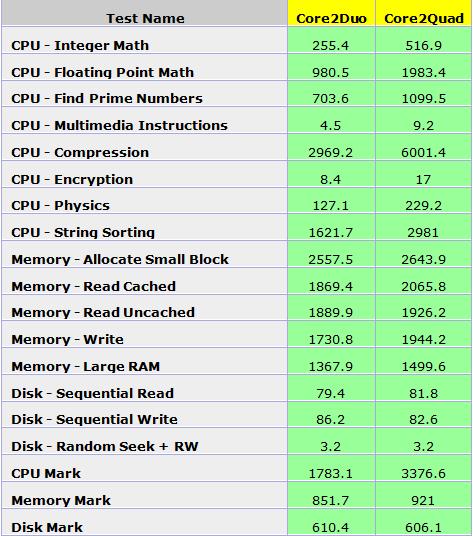
The result of multi-threaded tests is unambiguous - 4 cores are better than 2, all tests show this - a performance gain of almost 2 times.
Working with memory occurs at Core2Quad somewhat faster, hard drives work the same way.
The system's power consumption in the standby mode for both processors is the same - about 100W (0.5A), during the BurnIn test Core2Duo shows 130-140W (0.6A), Core2Quad 150-160W (0.7A).
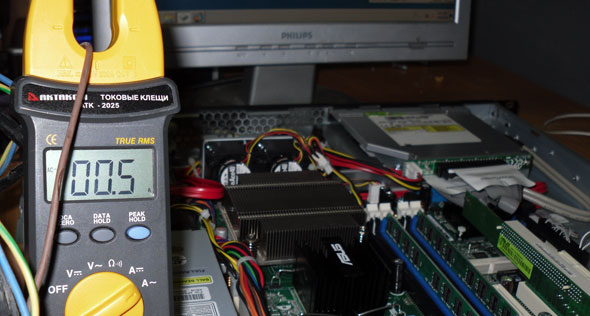
findings
What does this mean for us as a collocator? In a typical rack 42U you can put 40 of these machines + 2 katalista. Energy consumption will be about 5 kW. It is possible to take a rack (600x600), since the server is 38 cm deep. This frees up space in the data center, leads to resource savings - reduces the cost of operation, dedyk cheaper. The same type of configuration reduces the size of spare parts, allows you to change equipment within a few hours in case of an accident - we work on an SLA.
How is this comparable to other types of processors in terms of speed?
According to Passmark, the Pentium4 3.0GHz has a rating of 487 points, the new Core i7-860 2.8 GHz - 5594, the first-generation dual-processor Xeon at 3.2 GHz - 1300, one new Xeon E5530 2.4 GHz - 4563.
That is, the server based on Core2Duo is 4 times faster than the old P4 and faster than dual-processor systems on older Xeonas (single-core, with Hyper threading). If you need increased speed in multi-threaded computing - for example, a loaded web site on a CMS, then you need to take Core2Quad, it is not inferior to systems based on single-processor Xeon. The next performance step is dual processor machines or Core i7 as something intermediate.
Typical use of such entry-level servers is normal - web sites with exhaust of less than 100 Mbps, online stores, IP PBX based on Asterisk or MERA, hosting 1C accounting, remote workplace via RDP with a trading terminal, etc. Almost everything that cannot fit in a VPS due to real-time tasks or contains confidential information that no one should dig into - even the admin host.
As soon as we have the servers freed up or we will install new ones for customers, I will definitely measure them and post them here.
Platform
For the entry level, for unification purposes, we use the ASUS RS100-X5 platform. The motherboard on the 775 socket supports all Core2Duo, Core2Quad, Pentium D and Xeon 33xx, including the new processors on the 45nm process technology. 4 DDR2 memory slots, Intel SATA controller ICH7R for 2 ports (RAID 0.1), 2 Gigabit interfaces. Two closed seats for 3.5 ”HDD, integrated low-profile DVD-ROM. You can install an internal console access module with a separate Eth-port (ASMB3-iKVM) - you can remotely go to BIOS, reboot and monitor the server, etc. There is a PCI_X riser, you can put some specific board in it.
Included is a passive radiator and telescopic slide. As a feature, it is possible to note an amazing silence when the server is operating at a normal load - it is almost inaudible, the power supply of a regular desktop works louder.
')


Why precisely she? Firstly, one platform for all socket 775 processors closes the entry-level server niche and excludes the “zoo”. Secondly, low power consumption - about 100W in standby mode and 160W under full load. Thirdly, the support of the new 45nm xeon 33 series protects the investment and extends the service life of the server - in 3-4 years it will be possible to add a processor to the last of the line (which has not yet come out) and continue operation.
Tests
We decided to test one of the temporarily free servers and compare how the system behaves with a Core 2.Duo E7300 2.66GHz processor and a Core2 Quad Q9400 on the same 2.66GHz processor.
Intel Core 2 Duo E7300

Intel Core2 Quad Q9400

We tested the server with 4GB of memory Kingston, PC2-6400 (400MHz), 2 hard drives - 250GB of Seagate 7200.10, 16M cache and 1Tb Samsung 7200RPM 32M cache, OS - Win2008 Server 64bit. Test program - PassMark PerformanceTest 7.0 and Passmark BurnInTest.

The results are interesting only in comparison (we omit the graphics tests):

The result of multi-threaded tests is unambiguous - 4 cores are better than 2, all tests show this - a performance gain of almost 2 times.
Working with memory occurs at Core2Quad somewhat faster, hard drives work the same way.
The system's power consumption in the standby mode for both processors is the same - about 100W (0.5A), during the BurnIn test Core2Duo shows 130-140W (0.6A), Core2Quad 150-160W (0.7A).

findings
What does this mean for us as a collocator? In a typical rack 42U you can put 40 of these machines + 2 katalista. Energy consumption will be about 5 kW. It is possible to take a rack (600x600), since the server is 38 cm deep. This frees up space in the data center, leads to resource savings - reduces the cost of operation, dedyk cheaper. The same type of configuration reduces the size of spare parts, allows you to change equipment within a few hours in case of an accident - we work on an SLA.
How is this comparable to other types of processors in terms of speed?
According to Passmark, the Pentium4 3.0GHz has a rating of 487 points, the new Core i7-860 2.8 GHz - 5594, the first-generation dual-processor Xeon at 3.2 GHz - 1300, one new Xeon E5530 2.4 GHz - 4563.
That is, the server based on Core2Duo is 4 times faster than the old P4 and faster than dual-processor systems on older Xeonas (single-core, with Hyper threading). If you need increased speed in multi-threaded computing - for example, a loaded web site on a CMS, then you need to take Core2Quad, it is not inferior to systems based on single-processor Xeon. The next performance step is dual processor machines or Core i7 as something intermediate.
Typical use of such entry-level servers is normal - web sites with exhaust of less than 100 Mbps, online stores, IP PBX based on Asterisk or MERA, hosting 1C accounting, remote workplace via RDP with a trading terminal, etc. Almost everything that cannot fit in a VPS due to real-time tasks or contains confidential information that no one should dig into - even the admin host.
As soon as we have the servers freed up or we will install new ones for customers, I will definitely measure them and post them here.
Source: https://habr.com/ru/post/82759/
All Articles